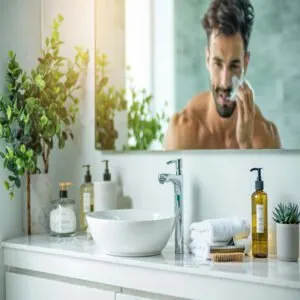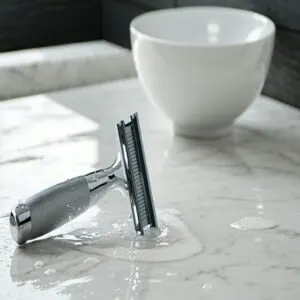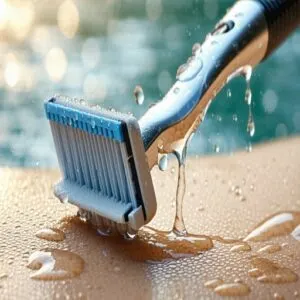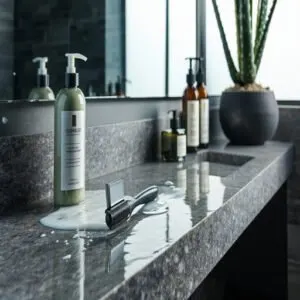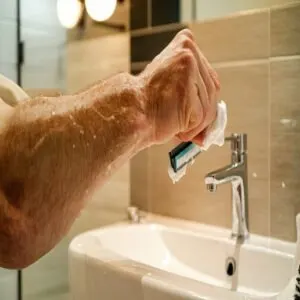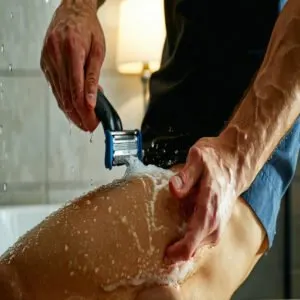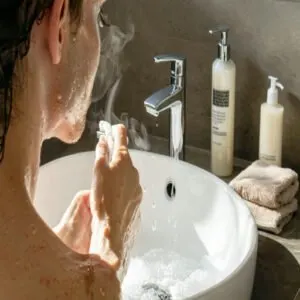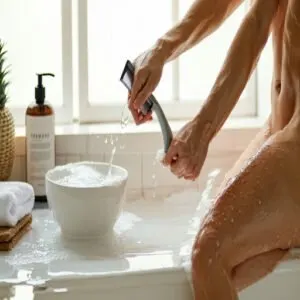This site is supported by our readers. We may earn a commission, at no cost to you, if you purchase through links.

Use a sharp razor (ditch the dull ones!) and shave in the direction of hair growth with short, light strokes.
Avoid pressing too hard or going over the same spot too many times.
Post-shave, rinse with cool water, pat dry, and apply an alcohol-free aftershave balm to soothe irritation.
Regular exfoliation helps, too, by clearing dead skin and preventing ingrown hairs.
Take control of your shave—your skin will thank you for it.
Stay smooth effortlessly!
Table Of Contents
- Key Takeaways
- Shaving Techniques Matter
- Preventing Razor Bumps
- Choosing Shaving Tools
- Shaving With Care
- Post-Shave Skin Care
- Reducing Irritation and Ingrown Hairs
- Maintaining Healthy Skin
- Frequently Asked Questions (FAQs)
- How do I shave without getting bumps?
- How to get rid of bumps down there from shaving?
- Why do I get so many bumps when I shave?
- How to shave down without bumps?
- Can diet impact the development of razor bumps?
- Are certain fabrics better for shaved skin?
- Does stress play a role in skin irritation?
- How does water hardness affect shaving results?
- Can weather changes increase risk of bumps?
- How often should I shave to avoid bumps?
- Conclusion
Key Takeaways
- Prep your skin by washing with warm water, exfoliating gently, and applying preshave oil to soften hair and prevent ingrown hairs.
- Always shave with a sharp razor in the direction of hair growth using short, light strokes to avoid irritation and bumps.
- Post-shave, rinse with cool water and apply an alcohol-free aftershave balm to soothe and hydrate the skin.
- Regularly exfoliate and moisturize to keep your skin smooth, healthy, and free from razor bumps.
Shaving Techniques Matter
You can transform your shaving routine from a painful experience to a comfortable one by mastering the right techniques and tools.
Your choice of razor, shaving direction, and pressure control will make the difference between dealing with irritating bumps and enjoying smooth, healthy skin.
Pre-Shave Preparation Steps
Start your shave right with skin hydration and easy prep steps.
Warm water softens the hair while exfoliation methods clear dead skin, avoiding razor bumps.
Follow these simple shaving preparation tips:
- Cleanse: Wash your face with warm water and a gentle cleaner.
- Use preshave oil: It softens hair and protects your skin.
- Lather up: Moisturizing shaving creams work wonders.
Proper skin prep techniques are essential for a smooth shave and minimizing bumps.
Choosing Right Shaving Tools
The right shaving tools can make or break your results.
Razor sharpness matters—dull blades irritate.
A safety razor or quality electric shaver offers more control and less pulling.
Prioritize razor blade quality, and look for shaving creams suited to your skin type.
For sensitive skin, avoid harsh blade materials.
Invest in quality shaving supplies for smoother, safer shaves.
Understanding the benefits of a safety razor kit can substantially improve shaving techniques and overall skin health.
Importance of Exfoliation
Before shaving, skin renewal is key.
Exfoliating techniques like gentle scrubbing help with cell removal, promoting bump-free shaving.
Use exfoliant types like scrubs or daily peeling pads to lift hairs and prevent ingrown hair.
Here’s how:
- Exfoliate 24 hours prior.
- Apply light pressure.
- Choose chemical or physical exfoliants.
- Avoid over-scrubbing.
- Focus on shaving bumps prevention.
The process emphasizes the importance of gentle scrubbing to ensure a smooth shaving experience.
Preventing Razor Bumps
Preventing razor bumps starts with understanding what causes them, like shaving too closely or using the wrong tools.
With a few smart adjustments, you can keep your skin smooth and irritation-free.
Causes of Razor Bumps
Razor bump causes often tie back to hair texture issues, like curly or coarse hair that curls into the skin.
Shaving dry skin, dull blades, or against the grain increases risk.
Skin irritation factors like sensitivity worsen razor bumps, also known as pseudofolliculitis barbae.
To prevent ingrown hairs and bump formation, avoid stretching skin and over-shaving during grooming.
How to Identify Triggers
Spotting trigger factors for razor bumps is like solving a small mystery.
Pay attention to irritation signs after shaving or patches prone to ingrown hairs.
Skin analysis helps you spot sensitivity, while tracking hair patterns reveals trouble areas.
If razor burn flares up often, tweak products or techniques to lead to smoother shaving results.
Role of Skin Type and Hair Texture
Think razor bumps have nothing to do with your skin or hair? Think again.
Skin sensitivity and hair texture play a major role in shaving techniques and outcomes.
For instance:
- Curly hair grows back into the skin easily.
- Dry skin can crack, making shaving rougher.
- Oily texture clogs pores during shaving.
- Sensitive skin reacts to harsh products.
- Hair porosity affects product absorption.
Choosing Shaving Tools
The right tools can make or break your shaving routine, especially if you’re prone to bumps.
Choose a sharp razor and a quality shaving cream to keep your skin smooth and irritation-free.
Sharp Razors for Sensitive Skin
Your shaving results hinge on blade sharpness.
A sharp razor glides smoother, reducing tugging and irritation—essential for sensitive skin shaving.
Pay attention to razor maintenance by replacing dull blades regularly.
Combine this with proper shaving angles to protect your skin.
Think of it as teamwork: sharp razors and good technique prevent razor bump removal from becoming a chore.
For effective shaving, using sharp razors is vital to achieve the desired smoothness.
Benefits of Multi-Blade Razors
In the case of bump-free shaving, multi-blade razors shine for their razor efficiency and smooth shave tips.
The extra blades guarantee closer hair management with less pressure, reducing nicks and razor bump risks.
Blade sharpness is key for skin comfort, so keep them clean.
For shaving technique perfection, these razors make tough curves a breeze.
Importance of Moisturizing Shaving Creams
Using quality moisturizing shaving creams is a game-changer for smoother skin.
They hydrate, reduce friction, and shield against irritation.
Compared to dry shaving, they’re your first defense against bumps.
Choosing the right shaving cream products can substantially impact the shaving experience.
- Look for cream ingredients like glycerin or natural oils for hydration.
- Shave gels are great for sensitive skin.
- Shaving cream reviews guide smarter picks.
Shaving With Care
When you shave with care, you’re less likely to deal with painful razor bumps later.
Simple techniques like shaving in the direction of hair growth and avoiding too much pressure can make all the difference.
Shaving in Hair Growth Direction
Understanding your hair growth patterns is key to bump-free shaving.
Always shave with the grain to avoid irritation and reduce ingrown hairs.
Use careful shaving angles, keeping light pressure on the razor. Gently pull the skin for better control and smooth results.
This follicle care method leaves you safer from razor bumps, making shaving techniques much more effective.
Using Short Strokes With Razor
Keeping your shave smooth and bump-free isn’t magic—it’s about mastering Razor Control.
Stick to short strokes, they help you maintain the right Shaving Angles, reduce shaving mistakes, and allow the blade to glide easier.
Don’t rush; let the razor do its job, with proper Stroke Length and light Skin Tension, you’ll avoid irritation and keep Blade Sharpness working for you.
Avoiding Over-Shaving and Pressure
Avoiding over-shaving and too much pressure is key for bump-free shaving.
Heavy-handed strokes irritate your skin, leaving razor burn instead of smoothness.
Stick to these tips:
- Use gentle strokes—let the razor do the work.
- Apply soft pressure for even results.
- Adjust razor angles for clean cuts.
- Maintain slight skin tension for smoother glides.
- Moderate your shave frequency.
Post-Shave Skin Care
Taking care of your skin after shaving is just as important as the shave itself to avoid irritation.
A little effort with the right products can keep your skin calm, smooth, and bump-free.
Rinsing With Cool Water
A splash of cool water after shaving does wonders.
It soothes the skin, calms irritation, and helps minimize razor burn.
The colder temperature encourages pore closure, reducing the chances of bumps or infection.
Think of it as a mini spa moment—quick, effective, and invigorating.
This simple step locks in all your hard work for bump-free shaving results.
Understanding the post shave routine is essential for maintaining healthy skin after shaving.
Applying Alcohol-Free Aftershave
To fend off post-shave irritation, use an alcohol-free aftershave balm loaded with calming ingredients like aloe or chamomile.
It soothes skin and provides hydration without that dreaded sting.
Think of it as razor bumps treatment in a bottle.
- Aftershave Benefits: Reduces redness and itching.
- Calming Ingredients: Look for soothing skin care heroes like witch hazel.
- Gentle Products: Avoid harsh alcohol-based solutions.
- Hydrating Solutions: Keeps skin soft and healthy.
Keeping Skin Moisturized Daily
After soothing your skin with an alcohol-free aftershave, lock in hydration daily with a lightweight moisturizer.
Moisturized skin heals faster and fends off dryness or irritation.
Choose hydrating skin products with aloe vera, glycerin, or natural oils for shaving aftercare.
| Frequency |
|---|
| Reduces irritation |
Reducing Irritation and Ingrown Hairs
If shaving leaves your skin itchy or bumpy, you’re not alone—ingrown hairs and irritation are common struggles.
By exfoliating regularly and choosing the right techniques, you can keep your skin smooth and your hair growing in the right direction.
Exfoliating Regularly
Exfoliation is your secret weapon for bump-free shaving.
Gentle scrubs or chemical peels promote skin renewal, lifting trapped hairs and preventing irritation.
Make it part of your daily routine, but don’t go overboard—twice weekly is plenty for most.
Pair this with other shaving tips, and you’ll see razor bumps removal and skin irritation solutions in no time.
Understanding the exfoliation best practices is key to maximizing the benefits of exfoliating for silky-smooth skin.
Avoiding Tight Clothing
In the case of bump-free shaving, what you wear afterward matters.
Tight clothes trap heat and increase friction, upsetting freshly shaved skin.
Opt for a loose fit and breathable fabrics like cotton to allow your skin to recover.
Proper fabric choice minimizes friction and irritation, offering razor burn relief.
Let your skin breathe—it’s a simple yet powerful shaving rash cure.
Considering Alternative Hair Removal
After avoiding tight clothes, consider if shaving is your best option.
Other hair removal methods can save your skin:
- Waxing Methods – Longer-lasting but a bit painful.
- Sugaring Techniques – Natural and great for sensitive skin.
- Depilatory Creams – Hassle-free but check for allergies first.
- Epilator Devices – Tugs but smooth results.
- Laser Removal – Expensive but practically permanent.
Maintaining Healthy Skin
Keeping your skin healthy after shaving isn’t just about looking good, it’s about preventing irritation and future issues.
Simple habits like changing your razor regularly and storing it properly can make a big difference in avoiding bumps and keeping your skin smooth.
Regularly Changing Razor Blades
Don’t let a dull blade ruin your skin.
Blade replacement is key to avoiding razor bumps and keeping a sharp edge, swap razor blades every 5-7 shaves, or if they tug or feel rough.
Proper razor maintenance, like drying and cleaning the handle, also prevents rust.
Sharp blades cut neatly, reducing irritation and ingrown hairs.
Proper Storage of Razor
A clean razor lasts longer, but storing it right is key.
Always dry your razor thoroughly after use to prevent rust, use storage tips like placing it upright or in a razor emporium product to avoid bacteria buildup.
Handle sanitizing helps too, proper blade maintenance and razor storage keep your shave smooth and extend razor longevity effortlessly.
Consulting Healthcare Professional for Persistent Issues
Dealing with stubborn razor bumps? Sometimes, it’s worth chatting with a pro.
Persistent issues could signal something more than shaving trouble. A doctor or dermatologist can offer solutions, like:
- Prescribing treatments for ingrown hairs.
- Addressing infections or skin conditions.
- Recommending gentle shaving alternatives.
- Guiding you on proper postshave treatments.
When it comes to sensitive skin, following dermatologist recommendations is vital for effective skincare routines.
Don’t sweat it—expert help guarantees safe, bump-free shaving long-term.
Frequently Asked Questions (FAQs)
How do I shave without getting bumps?
Go easy on your skin—shave with the grain, use short strokes, and don’t press too hard.
A sharp razor and a hydrating gel make a big difference.
Rinse with cool water, and moisturize afterward.
How to get rid of bumps down there from shaving?
Think of those bumps like uninvited guests—treat them with aloe vera or tea tree oil to soothe inflammation.
Exfoliate gently to free trapped hairs, and moisturize daily.
Let your skin heal before shaving again.
Why do I get so many bumps when I shave?
You’re probably shaving too close, against the grain, or with a dull blade.
Dry shaving or skipping exfoliation traps hair under the skin, causing bumps.
Using poor-quality razors or harsh products makes things worse.
How to shave down without bumps?
Go slow and shave with the grain using a sharp razor.
Hydrate your skin beforehand, exfoliate lightly, and avoid pressing too hard.
Finish with a soothing, alcohol-free balm to calm irritation and prevent bumps.
Can diet impact the development of razor bumps?
You mightn’t think diet matters, but it does.
Sugary, processed foods can inflame your skin, while staying hydrated and eating vitamins C and E-rich snacks (like oranges or nuts) helps keep bumps at bay.
Are certain fabrics better for shaved skin?
Soft, breathable fabrics like cotton and bamboo are best for shaved skin.
They minimize friction and irritation, letting your skin recover comfortably.
Avoid synthetic materials; they trap heat and sweat, making bumps worse.
Does stress play a role in skin irritation?
Stress can light a fuse under your skin’s sensitivity, making irritation flare up faster.
When life gets overwhelming, your body’s hormones can throw your skin’s balance off, leaving it more prone to redness, itching, and bumps.
How does water hardness affect shaving results?
Hard water, loaded with minerals, messes with your shaving cream, making it less foamy and less effective.
This leads to more friction, nicks, and bumps.
A water softener or distilled water can save the day.
Can weather changes increase risk of bumps?
When temperatures drop and humidity plummets, your skin dries out, making razor bumps more likely.
Winter’s chill isn’t just uncomfortable—it tightens skin, stiffens hair, and amplifies irritation.
Keep things hydrated to dodge those pesky bumps.
How often should I shave to avoid bumps?
Shave every 2-3 days to let your skin recover and avoid irritation.
Stretching it too long may lead to ingrowns, but daily shaving can overwork your skin.
Find a rhythm that feels right for you.
Conclusion
Mastering shaving techniques to minimize bumps doesn’t have to be tricky.
With proper prep, the right tools, and a gentle touch, you can enjoy smoother skin and fewer irritations.
Stick to shaving in the direction of hair growth, use sharp razors and moisturizing creams, and always finish with alcohol-free aftershave.
Keep exfoliating to prevent ingrown hairs, and don’t skimp on post-shave care.
Your skin will stay healthier, happier, and bump-free—so shaving becomes stress-free!

